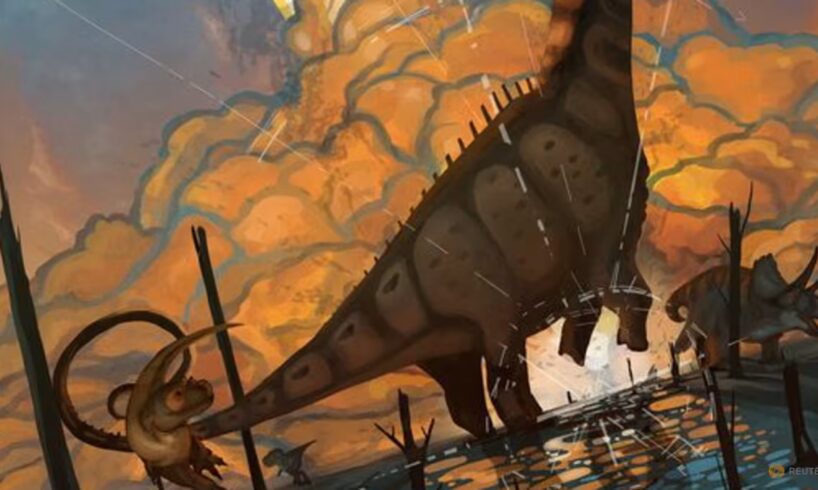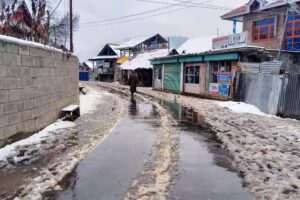
WASHINGTON : A fossil site in New Mexico with numerous dinosaurs, including the gargantuan Alamosaurus, dates to shortly before the asteroid strike that abruptly ended the age of dinosaurs, according to research that underscores that these creatures were still thriving on the eve of destruction.
Paleontologists have debated the age of fossils found at the Naashoibito site in northwestern New Mexico. The new study used two dating methods to determine that the fossils date to roughly 340,000 years – a blink of the eye in geological time – before the asteroid hit off the coast of Mexico’s Yucatan Peninsula 66 million years ago at the end of the Cretaceous Period.
The calamity erased three-quarters of Earth’s species including all the dinosaurs, aside from their bird descendants.
One of the dating techniques was based on the direction of Earth’s magnetic field at the time, as recorded in Naashoibito rock. The other involved measuring the decay of naturally occurring radioactive isotopes – forms of elements – in sand grains embedded in rock at the site.
“The age of the Naashoibito dinosaur faunas has been controversial for a long time, with some researchers suggesting that it was as much as 70 million years old, while others have suggested that it sampled the latest Cretaceous,” said paleontologist Dan Peppe of Baylor University in Texas, one of the authors of the study published in the journal Science.
The study provides the latest evidence contradicting the idea, once popular among paleontologists, that dinosaurs were in the midst of a worldwide decline before the asteroid strike.
The Naashoibito fossils found near Farmington, New Mexico, include numerous dinosaurs spanning various ecological niches. The biggest was Alamosaurus, which at 30-plus tons and roughly 100 feet (30 meters) long was one of the largest members of the plant-eating dinosaur group called sauropods that are known for their long necks and tails and their four pillar-like legs.
Other Naashoibito denizens include the huge apex predator Tyrannosaurus and the horned dinosaur Torosaurus, as well as duckbilled dinosaurs, armored dinosaurs and different types of bird-like dinosaurs.
The study revealed that the dinosaur community in the southern realm of North America differed from that present further north on the continent, as revealed by fossils from the contemporaneous Hell Creek rock formation covering Montana, North Dakota, South Dakota and Wyoming.
These two communities shared some dinosaurs such as Tyrannosaurus and Torosaurus but were distinct in other ways, showing a clear north-south division. For instance, while Alamosaurus was a prominent resident at Naashoibito, sauropods were completely absent up north. And the duckbilled dinosaurs were different in the south than the north.
“This shows that dinosaurs were not a single homogeneous community spread across North America that was prone to extinction. Instead they were diverse and abundant leading up to the end of the Cretaceous,” Peppe said.
University of Edinburgh paleontologist and study co-author Steve Brusatte said, “They were doing what dinosaurs had been doing for over 150 million years, adapting to their local conditions, dividing up niches in the food chain, varying in size and shape and diet and exhibiting rich diversity across the landscape. There is no sign that these dinosaurs were in any trouble, or that anything unusual was happening to them, or that they were in any type of long-term decline.”
Alamosaurus, also known from fossils found in Texas and Utah, was the last sauropod dinosaur known from North America and appears to have been restricted to warm climates.
“Nothing illustrates how dinosaurs were thriving up to the very end more than the fact that Alamosaurus, one of the biggest dinosaurs ever – in fact, one of the very biggest animals to ever live on land in the entire history of the Earth – was there to witness the asteroid,” Brusatte said.
“So not only were sauropods still around when the asteroid hit, they were still thriving, still sublime, still colossal, still glorious,” Brusatte said. “I can imagine the scene: one minute, a jet plane-sized dinosaur was shaking the ground as it walked, the next minute the whole Earth was shaking with the energy unleashed by the asteroid.”





